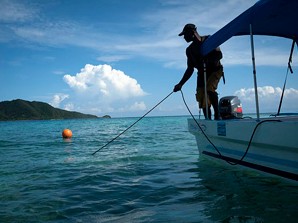
This issue of Global Waters focuses on the role of water security in addressing food security, and the challenges inherent in both. In this edition, we highlight five programs that demonstrate USAID’s ongoing commitment to employing effective water resources management – ranging from land-based agriculture to marine fisheries – to promote food security among some of the world’s poorest populations.
One billion people are estimated to lack sufficient water to meet their needs. Food scarcity affects approximately 925 million people each year. By 2050 world demand for food is predicted to double.
The primary challenge affecting water use and food production is that large segments of populations in developing areas already experience scarcities of both water and food on a daily basis. Physical scarcity, when there is not enough food and water available to meet the basic needs of households, is compounded by economics, when poor households simply do not have sufficient income to purchase what water and food is available.
The question facing the world becomes how we are to produce more food – often with less water - to meet the needs of growing populations when existing levels are inadequate. This calls for substantially greater efficiencies in the way that water is used to produce and process food, along with an understanding of which food production systems work best in different, and rapidly changing, ecosystems.
Increased food production must often be achieved within food systems that are at, or have surpassed, their ecological limits, often due to poor management. Terrestrial, freshwater, coastal, and marine ecosystems are all under stress and in some cases near collapse. Some rivers, such as the Yellow and Jordan Rivers, no longer reach the sea because their waters have been appropriated for agriculture, industrial, and household use, reducing the productivity of natural systems and fisheries. Groundwater levels in some areas, such as in Asia, have dropped more than 450 feet in two or three decades due to unsustainable levels of pumping for irrigation.
The path forward is to promote policies and programs that emphasize a “systems approach” to food production that integrates environmental and socioeconomic components. Food production is a socio-ecological system that comprises biophysical elements such as water, soil, crops and fisheries, as well as markets, livelihood strategies, policies and overall governance. A holistic, multi-level adaptive approach to management is needed to ensure productivity and long-term resiliency in the face of increasing demand for ecological goods and services, as well as impacts from climate change. Integrating the needs of ecosystems for water will be as complex as it is necessary, to the long-term success of any food production system. The Spiny Lobster Initiative highlighted in this issue provides one example of how USAID and its partners are addressing the issues associated with challenges across the entire fishery value chain.
To achieve maximum efficiency, productivity in food systems should be tackled at the landscape and seascape scale. This allows for more effective management than an approach focusing solely at the level of the farm or fishing vessel. Food production can and should take place within the context of eco-regional planning. The U.S. Coral Triangle Initiative Support Program illustrates efforts undertaken by USAID and its partners to encourage public participation and build collaborative partnerships on a multi-national, transboundary scale.
Productive agricultural lands in a given region can be used for farming while other areas can be left undeveloped to maintain vital ecological goods and services, such as regulating water flows and mitigating floods and droughts. The Middle East Water and Livelihoods Initiative (WLI) featured in our News from the Field Section offers one example of a multi-level approach to water and food security challenges that includes the field, farm, watershed, and basin. The project takes into account the interactions among people, resources, and the environment.
Building stewardship and a culture of water conservation is critical in water-scarce regions. Innovative programs such as the Meknès Pilot Project in Morocco that use treated wastewater for agricultural use have the ability to dramatically impact water resources management and food productivity in the region. Our article on President Obama’s Feed the Future initiative identifies land husbandry, water harvesting, and hillside irrigation techniques being employed in countries like Rwanda to make the crops more resilient to climate change.
USAID has several decades of experience in water and food production programs throughout the developing world. The Agency’s commitment to addressing the interdependent water and food crises has been renewed and invigorated. This edition of Global Waters brings to light some of the programs and partnerships that are dedicated to addressing that ongoing commitment.
~ The USAID Water Team
Please send your comments & suggestions to: waterteam@usaid.gov







Comment
Make a general inquiry or suggest an improvement.